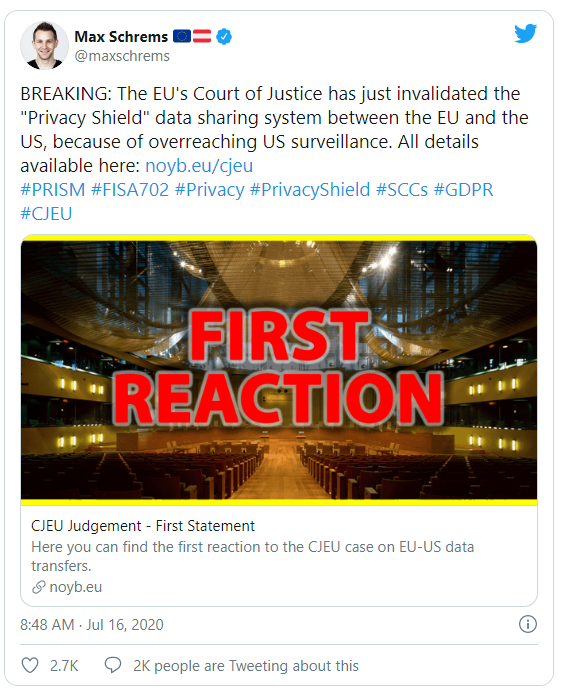Data Privacy News: Step-by-step guide to Schrems II and Privacy Shield’s invalidation, and what it means for you
Last Thursday, the Court of Justice of the EU (CJEU), the European Union’s top court, struck down the EU-US data sharing agreement, Privacy Shield, technically known as the EU-US Data Protection Shield.
The case known as Data Protection Commissioner v Facebook Ireland and Maximillian Schrems (also referred to as Schrems II) ruled that the data sharing agreement between the EU and the US, Privacy Shield, is not suitable as it does not provide adequate protection for EU citizens’ personal data when stored in the United States.

“The Court of Justice invalidates Decision 2016/1250 on the adequacy of the protection provided by the EU-US Data Protection Shield”
The above quote is the opening statement of the official press release from the CJEU regarding the case. Whilst the sentence appears simple enough, its ramifications are far more serious, and essentially puts thousands of businesses at risk of breaching GDPR.
Privacy Shield was one of the few mechanisms under GDPR where EU personal data could be transferred to the US, and with its immediate shut down, it leaves over 5,300 organizations who relied on this mechanism to find a new and safe way to transfer data.
The history behind the Schrems II ruling
What did they say and why?
The important thing to note is that this decision was not based on business practices within the US, but in fact, on the surveillance and the regulatory climate within the USA.
As the U.S. Chamber of Commerce Executive Vice President and Head of International Affairs states, “…[the case] focuses not on commercial uses of data, but on concerns over potential government access.”
There were two main rulings re Privacy Shield:
 |
US law enforcement agencies’ surveillance is not “limited to what is strictly necessary” – the EU standard. Therefore, any EU personal data transferred to the US under Privacy Shield is additionally – and unacceptably – exposed to surveillance. In fact, the judgement also revealed that strictly, US law states that surveillance on non-US citizens only needs to be “as tailored as feasible”. |
 |
Protection of EU citizens’ privacy rights in the US is too weak. Neither EU member states, nor the US Ombudsman (set up to help EU citizens make any case) have either the authority or the practical ability to enforce GDPR in the US. |
Considering these findings, it hardly comes as a surprise that the result came in as it did.
“In the light of all of the foregoing considerations, it is to be concluded that the Privacy Shield Decision is invalid.”
There was then an additional key ruling on Standard Contractual Clauses:
 |
Standard Contractual Clauses remain valid, though with a caveat that both the data “exporter” and “importer” must review whether the destination country offers a level of protection equivalent to that of the EU, and in particular what data access rights the country’s authorities may have. |
Given the surveillance and regulatory climate of the US, and the judgement also actively encouraging Supervisory Authorities to strike down any SCCs where the guarantees within them are not upheld or capable of being upheld, it is unclear for how long SCCs will survive as a recognised legitimate mechanism.
Unsurprisingly, guidance is soon expected from the EU and Supervisory Authorities, though in the meantime, SCCs are an entirely legitimate data transfer mechanism.
What does this mean in practice?
If your business transfers EU data subjects’ data to the US, you may need to take certain steps to ensure continued compliance with the GDPR.
Circumstances include:
- US-based organizations receiving data from EU customers
- Moving data internally within your organisation, for example from EU regional office to US HQ
- Using US suppliers for EU service delivery
- …and plenty more
If any of these or similar circumstances apply to you, we have set out below some “what if…?” scenarios to help guide your next steps.
1. What if I am Privacy Shield-certified?
Privacy Shield may be insufficient, but it is still in operation. The US Chamber of Commerce has stated that it will
“continue to administer the Privacy Shield program…[and] today’s decision does not relieve participating organizations of their Privacy Shield obligations.”
Therefore, if you are Privacy Shield-certified, you must maintain this certification unless you formally withdraw from the scheme.
However, on top of this certification, you will now have to implement another mechanism for the lawful transfer of EU Personal Data to the US.
2. What if I only rely on Privacy Shield to transfer personal data from Europe to the US?
The Judgement has determined that Privacy Shield does not offer suitable protections for the transfer of EU Personal Data to the US. This means that you must put in place one of the following mechanisms with immediate effect, and then update your data sharing policies and documentation to reflect the change.
Standard Contractual Clauses
This is likely to be the most common mechanism relied on for transferring personal data to the US.
SCCs are contract articles pre-approved by the EC for use by organisations performing international transfers of EU personal data. They create the necessary obligations – beyond those of typical GDPR compliance clauses found in many supplier contracts – for how the data should be handled by the receiving party (in this case, based in the US).
However, given the uncertainty over SCCs’ future usefulness, this risk ought to be entered on your risk register.
Binding Corporate Rules
Binding Corporate Rules (legal mechanisms that allow multinational companies to transfer EU personal data to entities outside Europe) would likely be suitable for protecting EU Personal Data moving to the US. However, these require Supervisory Authority approval and take months if not years to finalise. These are therefore unlikely to be a viable option unless your business already has Binding Corporate Rules already in place.
If you are in the process of putting in place Binding Corporate Rules that cover transfers to entities outside Europe, but these are not yet approved, then you will still have to utilise another mechanism pending their approval – most likely, Standard Contractual Clauses.
Derogations
There are limited situations in which transfers of personal data to the US may be permitted without any formal mechanism in place. You should obtain legal advice if you are intending to rely on a derogation, as their application is very limited.
Consent
If you do not believe you will be able to put Standard Contractual Clauses in place and none of the other mechanisms apply, you should obtain the consent of your European data subjects to any transfer of their personal data to the US.
Please note that this consent must still comply with GDPR requirements – i.e. it must be freely given, specific, informed, and unambiguous.
3. What if I already have Standard Contractual Clauses or Binding Corporate Rules in place?
Standard Contractual Clauses and Binding Corporate Rules continue to be recognised as an appropriate safeguard for personal data transfers outside Europe.
Note from our experts on SCCsTechnically, Standard Contractual Clauses only cover transfers from European controllers to non- European processors/controllers, the general consensus has historically been that they will not be challenged if used in relation to transfers from European processors to non-European sub-processors / controllers, although that may change with the new judgement.
Note too that some Data Processing Agreements may even expressly require the non-European based processor to put Standard Contractual Clauses in place with their non-European sub-processors. You should, nonetheless, get legal advice on whether Standard Contractual Clauses would be enforceable in these circumstances. |
Calligo designs continuous safety, privacy, and protection into every business data use, ensuring that every action is legal, ethical, and meaningful.
Find out more about our Data Privacy Services and how our experts in data privacy, data security and technology can build and support your data privacy programme by clicking below, or alternatively, contact the team directly, here.





 Back
Back